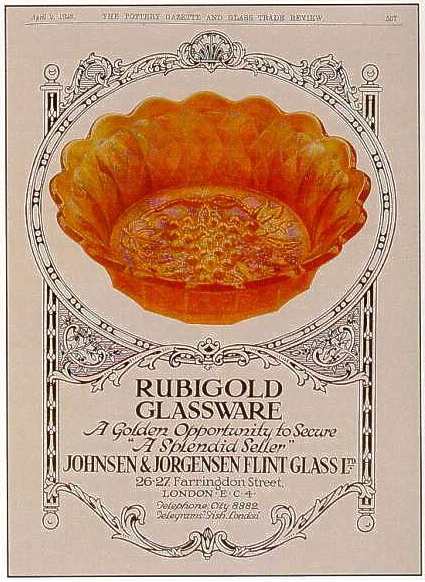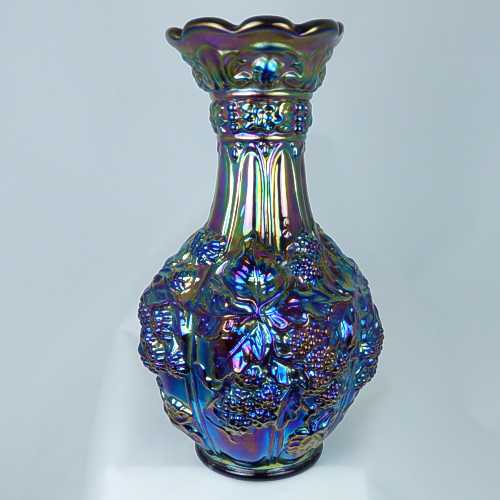Why "marigold" and what other colours was it made in?
Marigold. It’s the one, single colour that embraces and personifies Carnival Glass–its very heart and soul. The golden orange colouring comes from the iron chloride in the spray that was applied to clear glass (whilst still hot), creating a shimmering iridescence. Marigold was the first colour used by the Classic Carnival makers, evoking earlier iridescent glass that originated in Europe as well as Tiffany from the USA too.
|
In Stourbridge, England, Thomas Webb & Son had introduced their iridescent glass from 1878, calling their popular golden iridescent colour “Iris”.
The etching shown below is Thomas Webb & Sons' (Stourbridge, England) stand at the International Exhibition at the Garden Palace, Sydney, Australia in 1879, where iridescent glass was said to have been in the display. |
Three superb golden iridescent vases probably made in
Stourbridge, England in the late 1800s, early 1900s. Left to right: “Iris” vase by Thomas Webb & Sons, c. 1878 (WEBB’S IRIS GLASS is acid etched on the base); golden iridescent pedestal footed vase, possibly by Stevens & Williams; tiny, golden iridescent vase with prunts and moulded, threaded top, maker unknown. |
It’s interesting to note that early Carnival in the USA was often called “Golden Iris” clearly channelling the link with Webb’s golden “Iris” iridescent glass.
The text of a 1909 Butler Brothers catalogue ad for various early Fenton Carnival noted that it was “Designed and colored on the same principle as the exclusive imported goods” …”allover golden iridescent blendings reflecting rainbow hues”. The influence was clear. Marigold iridescence was, in effect, a copy-cat version of the earlier, expensive, iridised Art Glass.
Why marigold?
Marigolds (calendulas), with their vibrant orange blooms, were beloved of the Aztecs; indeed, they believed that they possessed not only magical and religious powers, but also had medicinal curative gifts. The Romans and Greeks loved marigolds too, often wearing crowns or garlands made from them. The brilliant orange colouring of marigolds is striking and unforgettable – and truly fitting as a descriptive term for the familiar shimmering orange of Carnival Glass.
Where and when did the term "marigold" originate?
That is the $65,000 question! And also, who used it? How did it get to become one of the most important words in the Carnival collector’s vocabulary?
|
Previously, the earliest reference we could find to the term "marigold" was in a book written in the 1950s by one of the American Pattern Glass "pioneers", Minnie Watson Kamm ("A Fourth Two Hundred Pattern Glass Book").
In it, she wrote about a pattern in iridised glass that she called "Marigold Windmill" (this being Imperial's Windmill design). Kamm explained that it was an imitation of Tiffany and Aurene glass, though in a much less expensive form, and she then added: "It was called 'Marigold Glass' at the Imperial plant from its bright coppery colour but it now goes by such names as 'Carnival Glass', 'Bronzy Glass', 'Lustre Glass'……" Based on Kamm’s narrative, we thought that perhaps the nickname “marigold” was first tagged by the Imperial workers and it just caught on. However, whilst browsing an Australian newspaper from 1925, we made a fascinating discovery, which turned this notion on its head. We found the ad shown on the right for “Bright Lights” bargain basement store. The ad describes a Star and File bowl as “A Bowl of Marigold Iridescence”. The four Imperial bowls (two Star and File and two Lustre Rose) are described as “A Group of Glories". |
|
Despite all four being what we know today as marigold, in an example of 1920s advertising at its best, a variety of promotional buzzwords were used to describe the colour of each piece: Rubigold, Sunrise, Sunset and ... yes ... Marigold. This Australian ad from 1925 is the earliest record we have found so far where the term marigold is used to describe the Carnival Glass colour. At that time, Imperial was officially describing the colour of such items as Rubigold. In fact the term Rubigold (for what we call marigold today) was used in ads and promotional releases from at least as early as 1910. Rubigold was the term of choice used by advertisers and stores around the world – so it’s fascinating and surely very significant that we see this early use of the word marigold in Australia, bucking the trend and setting out a new colour description that clearly caught on! Although Imperial still kept its term Rubigold (using it through the subsequent decades of re-issues), the word “marigold” took over gradually, as a generic term used by collectors for the popular Carnival colour from all the makers, worldwide. A 1912 ad in a Washington newspaper for Imperial’s
Open Rose bowl. Note the colour was described as Ruby-Gold. |
A 1923 British Pottery Gazette ad for Rubigold (marigold) Carnival by Imperial's
UK agent, Johnsen & Jorgensen, which features an Imperial Heavy Grape bowl. |
Why is there so much marigold?
In our opinion there are several reasons - appearance, cost, and style association.
Appearance: Some years ago, we were approached by Martha Stewart Living magazine, to contribute to a feature on Carnival Glass, with an emphasis on marigold. It was published in October, 2004, and Glen explained why she believed the colour marigold was a favourite purchase back in the early 1900s.
"To create marigold, however, clear glass is sprayed with iron chloride. Carnival Glass expert Glen Thistlewood, author of books on the subject and writer of an e-mail newsletter for the Woodsland World Wide Carnival Glass Association, speculates that marigold may have been a best-seller in the early twentieth century because indoor light levels were low and the furniture was dark. 'Put marigold on a mission oak table, light one small lamp, and the glass just glows.' Thanks to its popularity back when Carnival Glass was a novelty, marigold remains the most plentiful hue of all, and it is generally affordable. You can understand why most collectors start with marigold. That warm glow, evocative of harvest moons, jack-o'-lanterns, and turning leaves, has lost none of its original appeal."
Cost: Let's listen to Harry Northwood for a moment. "Ordinary Chloride of Iron as bought at wholesale drug stores costs 3½ cents a lb." Yep, it was cheap! The metal salts (ferric chloride) used to make marigold iridescence were inexpensive.
Style (or “Brand”) Association: Tiffany and Quezal as well as the famous Stourbridge glass firms of Stevens & Williams and Thomas Webb, all produced golden iridescent ware. Marigold iridescence was, in effect, a copy-cat version of the more expensive iridised art glass.
In reality there also are many different "shades" of marigold. The pieces below show just some of them. All of them were made by the same maker, Fenton, and are marigold, but (intentionally) they look very different!
A post script on marigold from Adam Dodds, Glass Technologist at the Sowerby glass works, 1949-56.
Adam was responsible for the re-introduction of Sunglow – Sowerby’s marigold Carnival – after WWII. Here is his amazing description of the process involved:
|
“At some point we were told that we were going to start making this fearsome stuff for the first time since WWII. It was called “Sunglow” - I had never heard of the name “Carnival” until recently. Any spraying equipment had long vanished so we raided the scrap yard next door and built our own. Someone produced the pre-war recipe for the witches' brew, which I made up and off we went.”
“We used the prewar mixture of ferric chloride (iron perchloride) crystals dissolved in methylated spirit. An old vertical boiler was fitted with a short chimney at the top and a door at the side, top hinged and opened by a foot pedal.” “After the glass article had been melted and shaped in the normal way and was still hot and attached to the punty, the ‘sticker-up’ pressed the pedal which opened the door, inserted the article, and the same pedal action turned on sprays inside. As soon as the spray hit the hot glass, clouds of green and brown smoke shot out of the chimney and spread around the upper (and sometimes lower) reaches of the glasshouse. The green would be chlorine; goodness knows what the rest was. Some of the stickers-up complained that their teeth changed colour and their shirts fell apart.” “What came out of the lehr varied from almost flint to almost black. The extreme ends were scrapped, the "middle cut" as it were went to normal customers and the "near misses" at either end were stored until early June each year when the showmen arrived for the huge fair (Carnival?) on Newcastle Town Moor. They took the lot at silly prices. To the best of my knowledge these were the only "seconds" of any sort which Sowerby’s sold.” |
Sowerby's Chunky - a pattern made in marigold in very substantial quantities (mounted in metalwork in this two-layer epergne is unusual).
|
What other colours was Carnival Glass made in?
There is a myth that marigold is the only colour of Carnival. It might be the first colour that comes into mind when you think of Carnival Glass, it is by no means the only one - there are lots more colours besides marigold.
Truth is, there are around sixty (yes, 60) or more Carnival colours defined and recognised by Carnival Glass collectors! Many of those shades are pretty rare though, and the colours you’ll see most often (after marigold) are blue, amethyst, purple and green. More unusual colours are pastel shades (like ice blue), UV reactive vaseline, red and opalescent effects.
Here are just a few:














